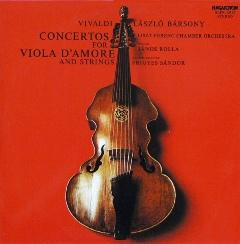Vivaldi - Concertos For Viola D'Amore And Strings (1980)
Vivaldi - Concertos For Viola D'Amore And Strings (1980)

A-Dúr Concerto RV 396 A1 I. Allegro 3:26 A2 II. Andante 4:29 A3 III. Allegro 3:30 D-Moll Concerto RV 394 A4 I. Allegro 4:44 A5 II. Largo 2:15 A6 III. Allegro 3:36 D-Moll Concerto RV 395 A7 I. Allegro 4:26 B1 II. Andante 2:11 B2 III. Allegro 3:19 D-Moll Concerto RV 393 B3 I. [Allegro] 3:30 B4 II. [Largo] 2:58 B5 III. [Allegro] 3:17 D-Dúr Concerto RV 392 B6 I. [Allegro] 4:43 B7 II. Largo 3:42 B8 III. Allegro 3:24 László Bársony - Viola d'Amore Mária Frank - Cello [Cello Continuo] Zsuzsa Pertis - Harpsichord [Harpsichord Continuo] Liszt Ferenc Chamber Orchestra János Rolla – Leader
The revival of the viola d'amore as an instrument distinct and separate from the viola is a well-established phenomenon, advanced by composers and performers alike at least since the 1920s. That doesn't mean, however, that there are a great many players of the viola d'amore around, nor are there nearly as many viola d'amores in existence to play, at least in a quantity relative to the number of violas that are out there. It is certainly an odd duck instrument; it has six or seven strings and a rank of sympathetic strings that vibrate along with the player, it puts out rich harmonics and has a mellow, somewhat nasal sound. Although it has earned a considerable number of nods from twentieth-century composers, its historical repertory is relatively small; Attilio Ariosti remains the all-time champion among Baroque composers for the viola d'amore, having written 21 sonatas for the instrument. Next in line is Antonio Vivaldi, with eight concertos and four arias with viola d'amore used in a concertante format. --- Uncle Dave Lewis, Rovi
download (mp3 @320 kbs):
uploaded yandex 4shared mega mediafire solidfiles zalivalka cloudmailru oboom
